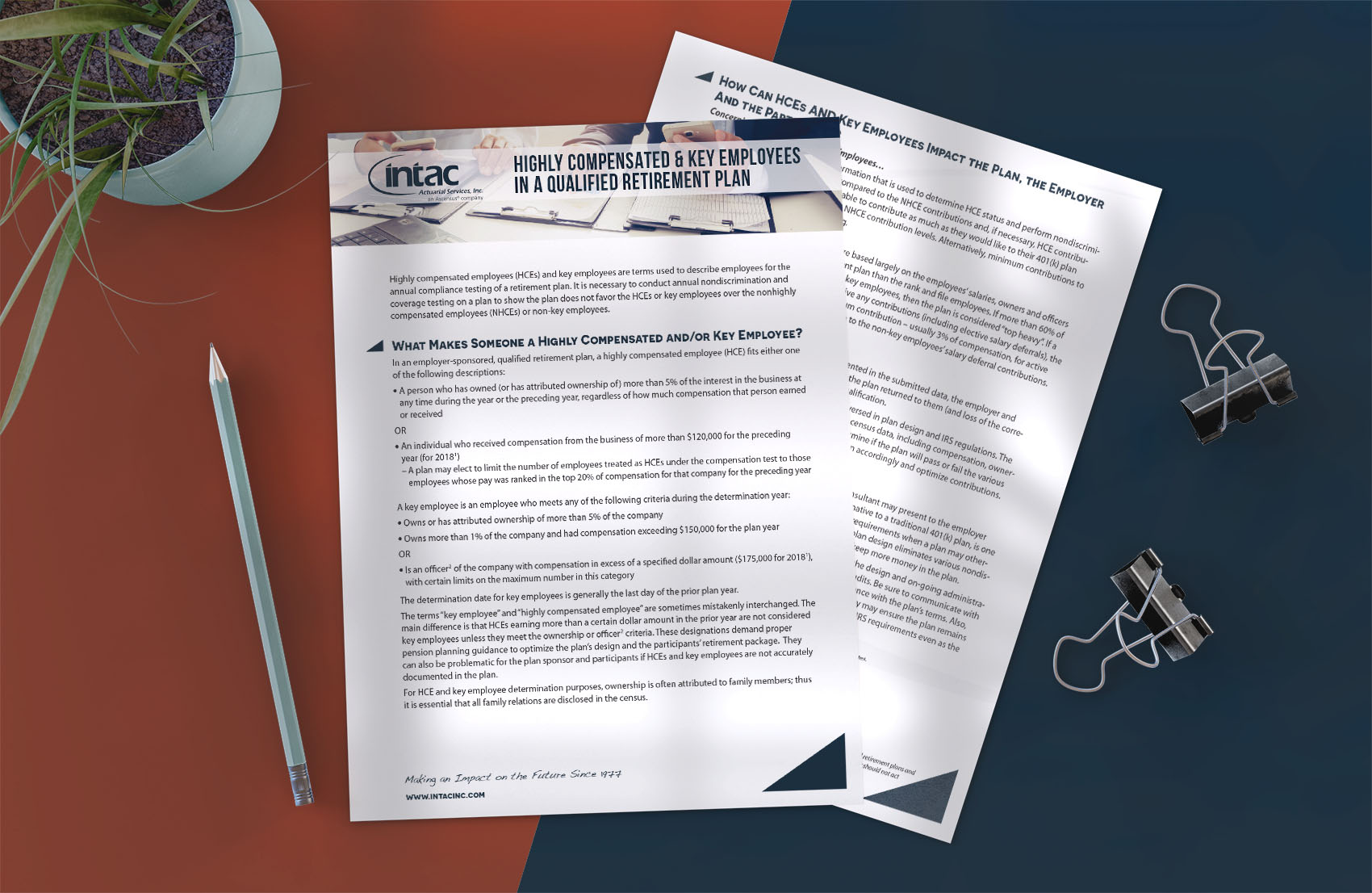Highly compensated employees (HCEs) and key employees are terms used to describe employees for the annual compliance testing of a retirement plan. It is necessary to conduct annual nondiscrimination and coverage testing on a plan to show the plan does not favor the HCEs or key employees over the nonhighly compensated employees (NHCEs) or non-key employees.
What Makes Someone a Highly Compensated and/or Key Employee?
In an employer-sponsored, qualified retirement plan, a highly compensated employee (HCE) fits either one of the following descriptions:
- A person who has owned (or has attributed ownership of) more than 5% of the interest in the business at any time during the year or the preceding year, regardless of how much compensation that person earned or received
OR
- An individual who received compensation from the business of more than $120,000 for the precedingyear (for 20181)
- A plan may elect to limit the number of employees treated as HCEs under the compensation test to those employees whose pay was ranked in the top 20% of compensation for that company for the preceding year
A key employee is an employee who meets any of the following criteria during the determination year:
- Owns or has attributed ownership of more than 5% of the company
- Owns more than 1% of the company and had compensation exceeding $150,000 for the plan year
OR
- Is an oflcer2 of the company with compensation in excess of a specified dollar amount ($175,000 for 20181), with certain limits on the maximum number in this category
The determination date for key employees is generally the last day of the prior plan year.
The terms “key employee” and “highly compensated employee” are sometimes mistakenly interchanged. The main difference is that HCEs earning more than a certain dollar amount in the prior year are not considered key employees unless they meet the ownership or oflcer2 criteria. These designations demand proper pension planning guidance to optimize the plan’s design and the participants’ retirement package. They can also be problematic for the plan sponsor and participants if HCEs and key employees are not accurately documented in the plan.
For HCE and key employee determination purposes, ownership is often attributed to family members; thus it is essential that all family relations are disclosed in the census.
How Can HCEs AND Key Employees Impact the Plan, the Employer And the Participant?
Concerning Highly Compensated Employees…
An employer reports census data information that is used to determine HCE status and perform nondiscrimi- nation testing. HCE contributions are compared to the NHCE contributions and, if necessary, HCE contribu- tions may be limited. HCEs may not be able to contribute as much as they would like to their 401(k) plan during any given year due to inadequate NHCE contribution levels. Alternatively, minimum contributions to NHCEs may enable the plan to pass testing.
Concerning Key Employees…
Since most plan contributions and benefits are based largely on the employees’ salaries, owners and oflcers often receive larger benefits from the retirement plan than the rank and file employees. If more than 60% of the value of the plan’s assets are attributable to key employees, then the plan is considered “top heavy”. If a 401(k) plan is top heavy and key employees receive any contributions (including elective salary deferrals), the plan sponsor must contribute a top heavy minimum contribution – usually 3% of compensation, for active non-key employees. This contribution is in addition to the non-key employees’ salary deferral contributions.
What Is My TPA’s Role?
If the HCEs and key employees are not properly represented in the submitted data, the employer and participant(s) are at risk of having their contributions to the plan returned to them (and loss of the corre- sponding tax incentives). There is also a risk of plan disqualification.
Therefore, it is important that the plan consultant be well-versed in plan design and IRS regulations. The pension consultant must analyze the current and prior year census data, including compensation, owner- ship, family relations and oflcer information. This helps determine if the plan will pass or fail the various nondiscrimination tests and to enable the plan sponsor to plan accordingly and optimize contributions.
Are There Plan Design Alternatives?
There are plan design options available that an expert pension consultant may present to the employer when designing the plan. A safe harbor 401(k) plan, a suitable alternative to a traditional 401(k) plan, is one option. The main difference is how a safe harbor plan meets the IRS’ requirements when a plan may other- wise have diflculty satisfying nondiscrimination testing. This type of plan design eliminates various nondis- crimination tests allowing HCEs and key employees to contribute and keep more money in the plan.
INTAC pension consultants integrate the most advanced strategies into the design and on-going administra- tion of a plan to help avoid top heavy liabilities, testing failure and plan audits. Be sure to communicate with your plan consultant to ensure proper employee classification and compliance with the plan’s terms. Also, provide your pension consultant with the requested census data so that they may ensure the plan remains at its optimal state with maximized benefits and continued compliance with IRS requirements even as the rules and regulations change throughout the years.
1 The compensation limit is updated from year to year based on annual cost of living adjustments by the IRS.
2 An employee who merely has the title of an oflcer but not the authority of an oflcer is not considered an oflcer for purposes of the key employee test.

